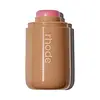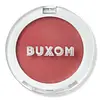rhode Pocket Blush Versus Buxom Cosmetics Plump Shot Collagen Peptides Advanced Plumping Cream Blush
What's inside
What's inside
 Key Ingredients
Key Ingredients

 Benefits
Benefits

 Concerns
Concerns

 Ingredients Side-by-side
Ingredients Side-by-side

Octyldodecanol
EmollientSynthetic Wax
AbrasiveHydrogenated Polyisobutene
EmollientCetyl Ethylhexanoate
EmollientPolyglyceryl-2 Triisostearate
EmulsifyingHydrogenated Poly(C6-14 Olefin)
EmollientBis-Diglyceryl Polyacyladipate-2
EmollientKaolin
AbrasiveSilica
AbrasiveMagnesium/Potassium/Silicon/Fluoride/Hydroxide/Oxide
Glycerin
HumectantCalophyllum Inophyllum Seed Oil
AntimicrobialPalmitoyl Tripeptide-1
Skin ConditioningPalmitoyl Tripeptide-5
Skin ConditioningCaprylyl Glycol
EmollientCaprylic/Capric Triglyceride
MaskingGlyceryl Caprylate
EmollientPentaerythrityl Tetraisostearate
EmollientAluminum Hydroxide
EmollientTriethoxycaprylylsilane
Water
Skin ConditioningPropylene Carbonate
SolventLauryl Polyglyceryl-3 Polydimethylsiloxyethyl Dimethicone
Skin ConditioningStearalkonium Hectorite
Gel FormingEthylhexylglycerin
Skin ConditioningCI 77891
Cosmetic ColorantIron Oxides
CI 45410
Cosmetic ColorantCI 42090
Cosmetic ColorantOctyldodecanol, Synthetic Wax, Hydrogenated Polyisobutene, Cetyl Ethylhexanoate, Polyglyceryl-2 Triisostearate, Hydrogenated Poly(C6-14 Olefin), Bis-Diglyceryl Polyacyladipate-2, Kaolin, Silica, Magnesium/Potassium/Silicon/Fluoride/Hydroxide/Oxide, Glycerin, Calophyllum Inophyllum Seed Oil, Palmitoyl Tripeptide-1, Palmitoyl Tripeptide-5, Caprylyl Glycol, Caprylic/Capric Triglyceride, Glyceryl Caprylate, Pentaerythrityl Tetraisostearate, Aluminum Hydroxide, Triethoxycaprylylsilane, Water, Propylene Carbonate, Lauryl Polyglyceryl-3 Polydimethylsiloxyethyl Dimethicone, Stearalkonium Hectorite, Ethylhexylglycerin, CI 77891, Iron Oxides, CI 45410, CI 42090
Dimethicone
EmollientIsononyl Isononanoate
EmollientMica
Cosmetic ColorantSilica
AbrasiveEthylhexyl Isononanoate
EmollientTrimethylsiloxysilicate
EmollientCaprylic/Capric Triglyceride
MaskingTribehenin
EmollientBoron Nitride
AbsorbentPolyethylene
AbrasiveHydrogenated Polyisobutene
EmollientRicinus Communis Seed Oil
MaskingSh-Polypeptide-123
Skin ProtectingSodium Hyaluronate
HumectantSqualene
EmollientChlorella Vulgaris Extract
Skin ConditioningSea Salt
AbrasiveAnemarrhena Asphodeloides Root Extract
Skin ConditioningPropylene Glycol
HumectantTocopheryl Acetate
AntioxidantPersea Gratissima Oil
Skin ConditioningSimmondsia Chinensis Seed Oil
EmollientCamellia Japonica Seed Oil
EmollientEthylhexylglycerin
Skin ConditioningHydrogenated Castor Oil
EmollientCocos Nucifera Fruit Extract
EmollientPEG-30 Dipolyhydroxystearate
EmulsifyingAlgin
MaskingCaprylyl Glycol
EmollientGlucose
HumectantMannose
HumectantTocopherol
AntioxidantBentonite
AbsorbentOlive Oil Decyl Esters
Ascorbic Acid
AntioxidantGlycerin
HumectantC20-40 Alcohols
EmulsifyingDipalmitoyl Hydroxyproline
Skin ConditioningTriethoxycaprylylsilane
Triethylhexanoin
MaskingCI 77220
Cosmetic ColorantWater
Skin ConditioningHydroxyapatite
AbrasiveCitric Acid
BufferingHydrated Silica
AbrasivePolyglyceryl-3 Diisostearate
EmulsifyingLactic Acid
BufferingIsopropyl Titanium Triisostearate
EmollientTriethoxysilylethyl Polydimethylsiloxyethyl Dimethicone
Skin ConditioningAlcohol
AntimicrobialPhenoxyethanol
PreservativeIron Oxides
CI 19140
Cosmetic ColorantCI 77891
Cosmetic ColorantCI 15850
Cosmetic ColorantDimethicone, Isononyl Isononanoate, Mica, Silica, Ethylhexyl Isononanoate, Trimethylsiloxysilicate, Caprylic/Capric Triglyceride, Tribehenin, Boron Nitride, Polyethylene, Hydrogenated Polyisobutene, Ricinus Communis Seed Oil, Sh-Polypeptide-123, Sodium Hyaluronate, Squalene, Chlorella Vulgaris Extract, Sea Salt, Anemarrhena Asphodeloides Root Extract, Propylene Glycol, Tocopheryl Acetate, Persea Gratissima Oil, Simmondsia Chinensis Seed Oil, Camellia Japonica Seed Oil, Ethylhexylglycerin, Hydrogenated Castor Oil, Cocos Nucifera Fruit Extract, PEG-30 Dipolyhydroxystearate, Algin, Caprylyl Glycol, Glucose, Mannose, Tocopherol, Bentonite, Olive Oil Decyl Esters, Ascorbic Acid, Glycerin, C20-40 Alcohols, Dipalmitoyl Hydroxyproline, Triethoxycaprylylsilane, Triethylhexanoin, CI 77220, Water, Hydroxyapatite, Citric Acid, Hydrated Silica, Polyglyceryl-3 Diisostearate, Lactic Acid, Isopropyl Titanium Triisostearate, Triethoxysilylethyl Polydimethylsiloxyethyl Dimethicone, Alcohol, Phenoxyethanol, Iron Oxides, CI 19140, CI 77891, CI 15850
 Reviews
Reviews

Ingredients Explained
These ingredients are found in both products.
Ingredients higher up in an ingredient list are typically present in a larger amount.
This ingredient is an emollient, solvent, and texture enhancer. It is considered a skin-softener by helping the skin prevent moisture loss.
It helps thicken a product's formula and makes it easier to spread by dissolving clumping compounds.
Caprylic Triglyceride is made by combining glycerin with coconut oil, forming a clear liquid.
While there is an assumption Caprylic Triglyceride can clog pores due to it being derived from coconut oil, there is no research supporting this.
Learn more about Caprylic/Capric TriglycerideCaprylyl Glycol is a humectant and emollient, meaning it attracts and preserves moisture.
It is a common ingredient in many products, especially those designed to hydrate skin. The primary benefits are retaining moisture, skin softening, and promoting a healthy skin barrier.
Though Caprylyl Glycol is an alcohol derived from fatty acids, it is not the kind that can dry out skin.
This ingredient is also used as a preservative to extend the life of products. It has slight antimicrobial properties.
Learn more about Caprylyl GlycolCi 77891 is a white pigment from Titanium dioxide. It is naturally found in minerals such as rutile and ilmenite.
It's main function is to add a white color to cosmetics. It can also be mixed with other colors to create different shades.
Ci 77891 is commonly found in sunscreens due to its ability to block UV rays.
Learn more about CI 77891Ethylhexylglycerin (we can't pronounce this either) is commonly used as a preservative and skin softener. It is derived from glyceryl.
You might see Ethylhexylglycerin often paired with other preservatives such as phenoxyethanol. Ethylhexylglycerin has been found to increase the effectiveness of these other preservatives.
Glycerin is already naturally found in your skin. It helps moisturize and protect your skin.
A study from 2016 found glycerin to be more effective as a humectant than AHAs and hyaluronic acid.
As a humectant, it helps the skin stay hydrated by pulling moisture to your skin. The low molecular weight of glycerin allows it to pull moisture into the deeper layers of your skin.
Hydrated skin improves your skin barrier; Your skin barrier helps protect against irritants and bacteria.
Glycerin has also been found to have antimicrobial and antiviral properties. Due to these properties, glycerin is often used in wound and burn treatments.
In cosmetics, glycerin is usually derived from plants such as soybean or palm. However, it can also be sourced from animals, such as tallow or animal fat.
This ingredient is organic, colorless, odorless, and non-toxic.
Glycerin is the name for this ingredient in American English. British English uses Glycerol/Glycerine.
Learn more about GlycerinHydrogenated Polyisobutene is a synthetic polymer. Polymers are compounds with high molecular weight. Hydrogenated Polyisobutene is an emollient and texture enhancer.
In one study, Hydrogenated Polyisobutene showed better skin hydration levels than Caprylic/Capric Triglyceride. As an emollient, it helps keep your skin soft and hydrated by trapping moisture in.
Hydrogenated Polyisobutene is often used as a mineral oil replacement.
Learn more about Hydrogenated PolyisobuteneSilica, also known as silicon dioxide, is a naturally occurring mineral. It is used as a fine, spherical, and porous powder in cosmetics.
Though it has exfoliant properties, the function of silica varies depending on the product.
The unique structure of silica enhances the spreadability and adds smoothness, making it a great texture enhancer.
It is also used as an active carrier, emulsifier, and mattifier due to its ability to absorb excess oil.
In some products, tiny microneedles called spicules are made from silica or hydrolyzed sponge. When you rub them in, they lightly polish away dead skin layers and enhance the penetration of active ingredients.
Learn more about SilicaTriethoxycaprylylsilane is a silicone used to bind and stabilize ingredients.
As an emulsifier, it helps prevent ingredients from separating. This can help elongate the shelf life of products.
Triethoxycaprylylsilane is often used to coat mineral sunscreens ingredients to help give a better feel. It also helps reduce oxidative stress in sunscreens.
Learn more about TriethoxycaprylylsilaneWater. It's the most common cosmetic ingredient of all. You'll usually see it at the top of ingredient lists, meaning that it makes up the largest part of the product.
So why is it so popular? Water most often acts as a solvent - this means that it helps dissolve other ingredients into the formulation.
You'll also recognize water as that liquid we all need to stay alive. If you see this, drink a glass of water. Stay hydrated!
Learn more about WaterThis ingredient is a combination of red, black, and yellow iron oxide pigments. This combination of colors is usually found in foundation, because it results in a "skin" color.